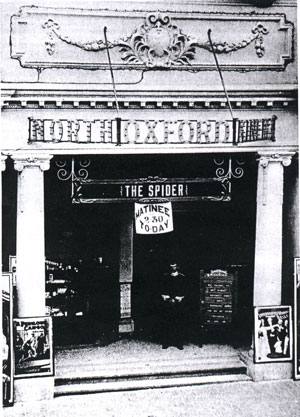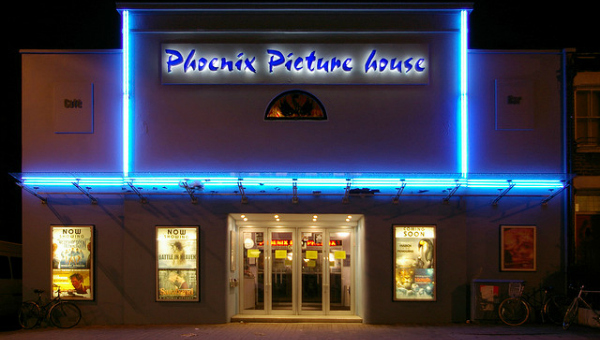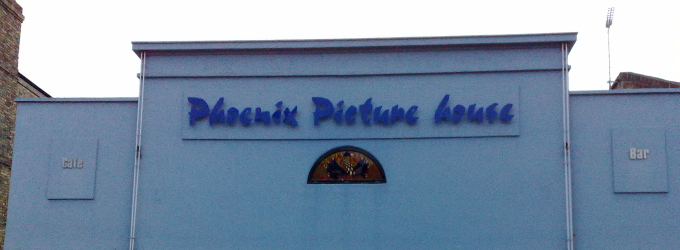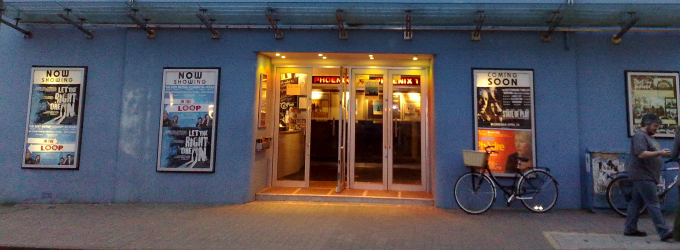
There aren’t many cinemas left in this country that are over 100 years old. The Duke of York’s in Brighton, Ritzy in London, the Ultimate Picture Palace in Oxford, and now… Happy Centenary, Phoenix Picturehouse Cinema!
15th March 2013 marks the centenary anniversary of the Phoenix Picturehouse Cinema in Oxford. I have been tearing tickets at the cinema since August 2008, and the cinema has almost become my second home. Therefore, I feel I should introduce this treasured cinematic landmark to those who haven’t yet visited.
The cinema building was designed by local architect Gilbert Gardner. The North Oxford Kinema opened on 15 March 1913 under proprietors Richard Henry John Bartlett, W. Beeson, and Charles Green. The cinema’s early years remained unstable, with no less than seven operators trying their hand during the 1910s and 1920s. Others were Hubert Thomas Lambert (1917-20), C. W. Poole’s Entertainments (1920-23), Walshaw Enterprises (1923-25), Ben Jay (1925-27), J. Bailiff (1927-28), and Edward Alfred Roberts (1928-30).
Their introduction of late shows was popular with students, although less popular with the neighbours…
In June 1930, The Scala (as Poole’s had renamed it) finally gained some stability after its purchase by John Edward Poyntz. He installed sound, and instigated a business plan of screening subtitled films to students to help them learn languages. A burgeoning interest in the artistry and politics of world cinema led to the launch of the Oxford Film Society in 1933. Significant structural alterations to the facade and interior were made in 1939. Programmed by Mr. Poyntz’s son-in-law Eric Bowtell, in the 1950s and ’60s The Scala came to be known as one of the UK’s foremost regional art cinemas.
The cinema was sold to Star Associated Holdings in the 1970s. They converted many of their cinemas wholly or partly to bingo (the main part of their business); luckily The Scala escaped this change of usage. Star ‘twinned’ the cinema and renamed it Studio 1 & 2. Barred by the larger exhibition chains from showing the top English-language titles on first release, and uninterested in subtitled cinema, Star’s programming policy relied heavily on the growing availability and popularity of sex films.
In 1989, the cinema was sold to Lyn Goleby and Tony Jones of City Screen…
In 1977, Star subleased the cinema to Charles and Kitty Cooper of Contemporary Films, who renamed it The Phoenix and changed the programming again. Contemporary had been a leading art house distributor since 1951 and, in the 1970s, they diversified into exhibition, with The Phoenix becoming their third and final cinema. In these years, new and classic foreign-language titles sat alongside cult movies. Their introduction of late shows seven days per week was popular with students, although sometimes less popular with the neighbours.
In 1989, the cinema was sold to Lyn Goleby and Tony Jones of City Screen, and became the first cinema in the Picturehouse group. Popular changes introduced in the Picturehouse era include installation of the bar in 1994 and the launch of live satellite broadcasts of opera, theatre, and ballet in 2006.
In order to celebrate such great event, the cinema will be holding special screenings of classic films over the whole year. A wider research was established by Dr Deborah Alison (programmer of the Phoenix), Dr Daniela Treveri Gennari (head of Film Studies at Oxford Brookes) and me as the Phoenix Centenary Project. We have been collecting and researching information about the cinema’s history and memory. Literature will be published towards the end of this year, that collects more of the historical photography of the cinema, history and customers memories from interviews. In the meantime, please feel free to visit the project website where you can find read more about the project, and download a free copy of the cinema film archive. The archive lists almost all the films the cinema has shown the past 100 years, and includes over 21,000 film titles!




As a film lover and lover of film history in all its forms (production,
exhibition, etc.), and someone who’s watched many films at The Phoenix,
this is so exciting that you’re covering its 100th anniversary! I first
visited England as a teenager and saw my first film at The Phoenix:
“The Madness of King George,” which was a good film, although I longed
to go see my idol Gus Van Sant’s “My Own Private Idaho,” as the cinema
was screening the film in honor of the late River Phoenix who passed
away a few months before. I attended a doc fest there a few years back,
saw Loach’s “The Wind that Shakes the Barley” with my mother, and
remember going with a friend and squeezing into a fully packed house
during a screening of “The Seventh Seal” right after the news of Ingmar
Bergman’s death. It’s such a great theater, and has now become even
greater for me personally considering its long history! I haven’t been
to Oxford in a few years, but whenever I visit, I always go for at least
one show at The Phoenix in Jericho.
Dear Kyna, Thank you very much for your comment and sharing your memory of the Phoenix. The cinema is indeed a very special place. Please do come for a visit next time you are in Oxford again. There is a special edition, A4 hardback Phoenix film archive 1913 – 2013 being displayed at the bar on the second floor. Perhaps you will dig some more films you have watched at the cinema from there. WIth best wishes, and thank you for your nice comments again. – Hiu
There will also be another literature that covers more of the cinema’s history, audience’s memory later on. It will be published at the end of 2013. We hope you will find that interesting too.